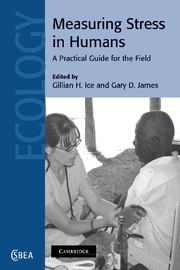Book contents
- Frontmatter
- Contents
- Contributors
- Foreword by Geoffrey A. Harrison
- Part I General principles
- Part II Measuring stress responses
- 2 Cultural dimensions of the stress process: measurement issues in fieldwork
- 3 Measuring emotional and behavioral response
- 4 Measuring hormonal variation in the sympathetic nervous system: catecholamines
- 5 Measuring hormonal variation in the hypothalamic pituitary adrenal (HPA) axis: cortisol
- 6 Measuring physiological changes in the cardiovascular system: ambulatory blood pressure
- 7 Measuring immune function: markers of cell-mediated immunity and inflammation in dried blood spots
- Part III Practical issues in studying stress
- Index
- References
2 - Cultural dimensions of the stress process: measurement issues in fieldwork
Published online by Cambridge University Press: 11 September 2009
- Frontmatter
- Contents
- Contributors
- Foreword by Geoffrey A. Harrison
- Part I General principles
- Part II Measuring stress responses
- 2 Cultural dimensions of the stress process: measurement issues in fieldwork
- 3 Measuring emotional and behavioral response
- 4 Measuring hormonal variation in the sympathetic nervous system: catecholamines
- 5 Measuring hormonal variation in the hypothalamic pituitary adrenal (HPA) axis: cortisol
- 6 Measuring physiological changes in the cardiovascular system: ambulatory blood pressure
- 7 Measuring immune function: markers of cell-mediated immunity and inflammation in dried blood spots
- Part III Practical issues in studying stress
- Index
- References
Summary
Introduction
The aim of this chapter is to examine measurement issues in the social and cultural study of the stress process. More specifically, the aim is to clarify a methodological orientation that can guide anthropologists and other fieldworkers interested in stress processes within specific social and cultural contexts. As such, this chapter is partly a review of how stress has been measured in many different studies, and partly an examination of the logic of measurement in anthropology and how it can be improved to understand the stress process. The chapter is intended as a supplement to the volume edited by Cohen et al. (1995) that reviewed issues of measurement in studies of the stress. It helps to extend that review in terms of addressing questions pertinent to the study of social and cultural dimensions of the stress process.
Culture and the stress process
In Chapter 1, Ice and James outlined the general conceptual model that guides much of research on the stress process. As they make clear, at one level it can be difficult to separate elements of the process (e.g. when is an environmental challenge an acute or a chronic stressor or when is the emotional state of the individual indicative of a stress appraisal or a coping response?). At the same time, for there to be a sensible measurement model applied to the process, conceptual distinctions need to be made.
In this chapter, I will adhere to the model outlined in Chapter 1, but with a few additions.
- Type
- Chapter
- Information
- Measuring Stress in HumansA Practical Guide for the Field, pp. 27 - 59Publisher: Cambridge University PressPrint publication year: 2006

